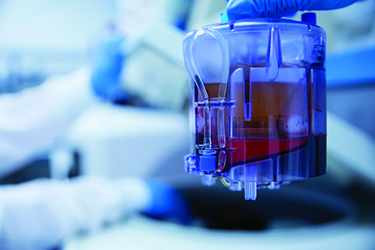Peripheral Blood Mononuclear Cell Isolation

Peripheral blood mononuclear cells (PBMCs) are valuable for both clinical and research applications. Isolating pure populations of PBMCs from whole blood traditionally requires sample dilutionand use of a density gradient medium to deplete red blood cells (RBC), granulocytes (GRN) and platelets (PLT).1 This open, manual process involves a high risk of contamination. In addition, selective loss of specific populations of lymphocytes2,3 and phenotypic discrepancies have been associated with the use of density gradient media.4-6 Further, this method involves multiple tedious steps that are dependent upon highly skilled laboratory personnel, making the process cost-ineffective and standardization very difficult.7 To be compliant with current good manufacturing practices (cGMP), manufacturers of cellular therapies must find alternative methods of PBMC isolation that are user-independent, reproducible, and closed to ensure sterility.
PBMC Protocol using the Corning® X-LAB® System
The Corning X-LAB System is a functionally closed, sedimentation-based system that reliably and reproducibly isolates PBMCs without the need for density gradient media or manual transfer steps. The X-LAB System features fully customizable protocols that can process 40 to 240 mL of source material and isolate mononuclear cells (MNC) in a user-defined harvest volume between 3 to 40 mL in just 35 minutes. The PBMC Protocol using the X-LAB System automates MNC isolation by compartmentalizing RBC/GRN, MNC, and plasma/PLT fractions using highly sensitive infrared sensors to ensure reproducibility of the manufacturing process.
Get unlimited access to:
Enter your credentials below to log in. Not yet a member of Cell & Gene? Subscribe today.
